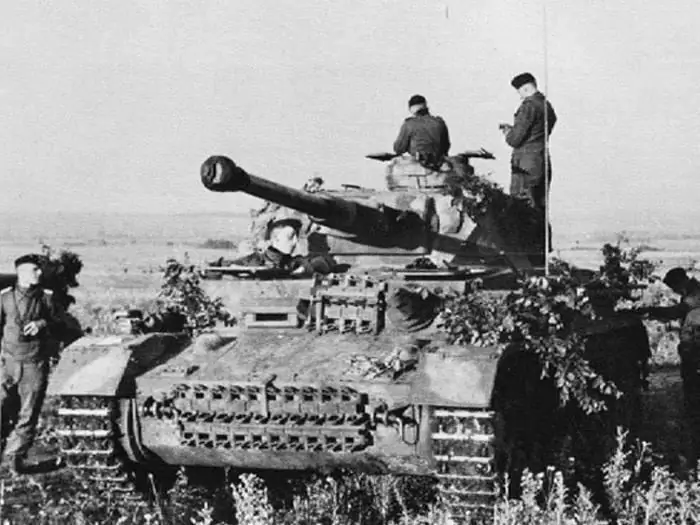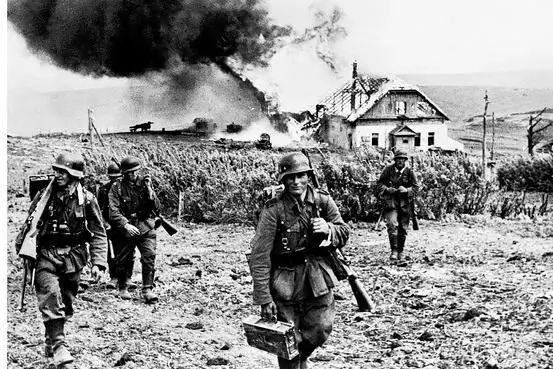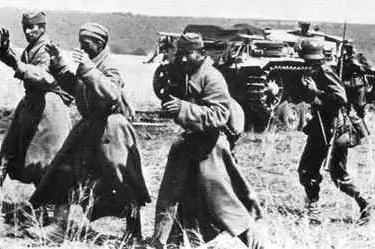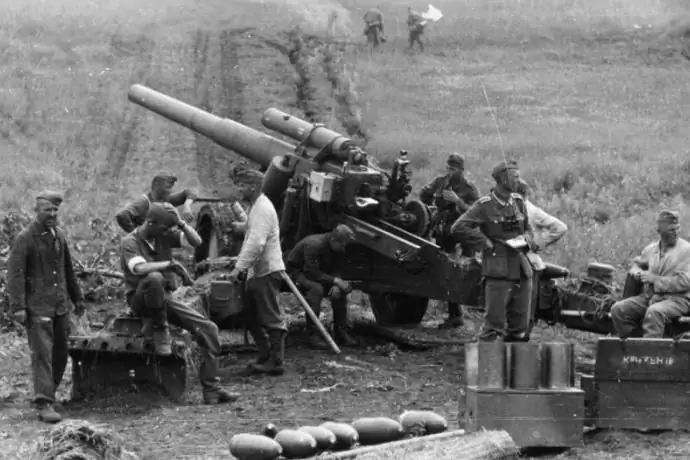As you know, from the first days of the Great Patriotic War and for several months, Soviet troops retreated along the entire length of the country's western border. For the first time, the enemy's rapid advance was stopped only in November 1941, on the outskirts of Moscow. Then, at the cost of incredible efforts, the Red Army managed to push back the Nazis. This gave the military command reason to be sure that the troops were ready to conduct offensive attacks. However, such delusions led to a disaster near Kharkov.

Initial plan
By the time when the attack of the German troops was successfully stopped, and, moreover, the enemy was thrown back from the Moscow borders at a fairly decent distance, most of the industry was evacuated beyond the Urals, where in several shifts most enterprises were actively production of military equipment. The supply of weapons to the active army has normalized, in addition, the personnel of the army has grown significantly. Already in the second quarter of 1942, it was possible to form not only a replenishment for the active army, but also nine reserve armies.
Based on these circumstances, the high command decided to develop several offensive operations in different directions of the front in order to demoralize the enemy, prevent him from uniting his armies, cut off the southern front of the Germans and, pinning them, destroy them. Among the strategic operations was the Kharkiv pocket of 1942.
Composition of the future collision
From the Soviet side, it was decided to include in the battle the armies of three fronts at once - Bryansk, South-Western and Southern. They included more than ten combined arms armies, as well as seven tank corps and more than twenty separate tank brigades. In addition, a reserve was brought up to the front line, which consisted of additional tank formations. The Kharkov cauldron of 1942 was carefully prepared, so that more than 640 thousand fighters, including officers, and 1, 2 thousand tanks were prepared for participation in future battles.
The command of the entire operation was also entrusted to the first persons of the country's military leadership. Among the leadership was the head of the Southwestern Front, Marshal Semyon Timoshenko, the headquarters was headed by commander Ivan Bagramyan, as well as Nikita Khrushchev. At the head of the Southern Front at that time was Lieutenant General Rodion Malinovsky. Hitler's forces were led by Field Marshal Fedor von Bock. The total force consisted of three armies, including the Sixth Army of Paulus. For its part, the Wehrmacht called the operation the Kharkov Cauldron of 1942 "Fredericus".

Preparatory work
In early 1942, Soviet troops began preparatory maneuvers. Beganthe formation of a strong bridgehead by units of the South-Western Front in the Kharkov region near the city of Izyum, near the Seversky Donets River, on the western bank of which it was possible to create a support for a further offensive on Kharkov and Dnepropetrovsk. In particular, the Soviet army managed to cut the railroad, which was used to supply enemy units. However, spring and the slush that came along with it interfered with the war plans - the offensive had to be stopped.

Be ahead of the curve
According to the plans of the German high command, it was assumed that the Kharkov cauldron of 1942 would initially be expressed in the destruction of the bridgehead created by the Soviet army, and then in the encirclement. The attack of the Nazis was supposed to begin on May 18, but the Red Army ahead of the Germans, starting to advance six days earlier. The operation began with simultaneous attacks on enemy units from the north and south. According to the strategy of the Soviet command, the Sixth Army was to be surrounded - in the Kharkov cauldron. The year 1942 seemed quite promising from the very beginning - at first, the plans of the Soviet formations were successfully implemented. Five days later, they really managed to push the Germans to Kharkov.
At the same time, from the south side of the Germans, three Soviet armies were pushing at once, which managed to break through the German defenses and run into small places where long fierce battles began. In the north, during the first days of the operation, it was possible to penetrate 65 kilometers into the German defenses. However, the Southwestern and Southern Fronts did not prove themselvesquite active, which allowed the Germans to orient themselves in the situation in time and regroup troops, withdrawing entire units from the attacked areas.

First failures are harbingers of disaster
Operation "Kharkov Cauldron" (1942) was successful for the Soviet side only in the first few days. By the end of the fifth day of fighting, it became clear that everything was not going according to plan. By this time, the defense should have been quite seriously broken through, and the Soviet troops should have moved far ahead, but they still stomped on the front line. In the northern sector, defensive battles against German attacks dragged on. Historians note that already in the first days, the units attacking from the southern and northern sides acted inconsistently. At the same time, the formations of the Southern and Southwestern fronts acted inconsistently at all, which created serious failures in the operation.
In addition, no reserves were formed, the preparation of engineering structures and barriers was at an extremely low level. As a result, no hard defense was provided on the south side. This was partly the reason that the Kharkov boiler of 1942 eventually turned into a real disaster for the Soviet troops. Do not forget that the command did not at all assume the possibility of a German offensive during the operation. The created bridgehead inspired such confidence.

Kickback
German troops also planned to deliver two strikes from the south side of the bridgehead in order to developfurther attack on Izyum. The Ninth Army was responsible for this sector. It was planned that the Nazis would break through the Soviet defenses and cut the troops into two parts in order to surround them and destroy them separately. Further, it was supposed to continue the offensive to destroy the entire group of armies that had settled on the bridgehead.
On the fifth day of the battle, the First Tank Army of the enemy managed to break through the defensive supports of the Red Army and strike. We add that even on the first day they were able to cut off one of the armies of the Southern Front from the main forces and in ten days to exclude the possibility of their retreat to the east. Probably, even then the Kharkov cauldron of 1942 (photos related to the events are presented in the review) was doomed. Timoshenko, realizing the desperation of the situation, asked Moscow for permission to retreat. And although Alexander Vasilevsky, at that time already appointed chief of the General Staff, allowed, Stalin said his categorical "no". As a result, already on May 23, more Soviet units were surrounded.

Enemy Trap
From that moment on, the Red Army stubbornly tried to break through the blockade. In particular, German officers recalled desperate and intense attacks by an incredibly large number of infantry. Attempts were not particularly successful: three days after the start of the encirclement, the Soviet units were driven into a relatively small area near the small town of Barvenkovo. It was only the first stage of the Second World War. The Kharkov pocket was only a logical consequence of insufficient preparedness andinconsistency of actions. Due to the strong defense of the Germans, the Soviet units failed to get out of the encirclement. And Tymoshenko had no choice but to stop the offensive operation.
Nevertheless, attempts to get our people out of the encirclement continued for several more days. Despite the huge losses (the list of the dead was literally endless), the Kharkov cauldron managed to break through a little near the village of Lozovenki. However, only a tenth of those who fell into it could escape from the trap. It was a crushing defeat. Those who died in the Kharkov cauldron of 1942 - 171 thousand people - literally gave their lives just like that, one might say, because of Stalin's whim. The total number of losses reached 270 thousand.
Disastrous consequences
The most important consequence of the failure was the total weakening of the Soviet defense along the entire length of the Southern Front. Quite large forces were invested in the Kharkov cauldron (1942). The collapse of hopes for a turning point in the war was too painful. And the Wehrmacht, of course, made good use of it.
The Nazis launched large-scale offensives in the direction of the Caucasus, as well as the Volga. Already at the end of June, passing between Kharkov and Kursk, they broke through to the Don. The Kharkov Cauldron of 1942 cost a lot - the lists of the dead were replenished by several high-ranking military leaders, including commanders of armies and fronts. But even during the retreat of parts of the Southwestern Front, the losses turned out to be considerable. While the Germans took Voronezh and moved to Rostov, the Soviet army lost from 80 to 200 thousand soldiers as prisoners. Taking Rostov towards the end of July, inIn early August, the enemy reached Stalingrad, a line that the Germans would no longer be able to cross.
Konstantin Bykov wrote a book about the current situation near Kharkov, as about the last triumph of the Wehrmacht on the territory of the USSR, "Kharkov Cauldron of 1942".

Return to Kharkov
In fact, the battles on the Kharkov borders were more than once. And this is understandable. Hitler began his offensive precisely from Belarus and Ukraine. On the approaches to Kharkov, the Soviet troops had already begun to navigate and learned to repulse the enemies. So, the first Kharkov boiler in 1941 "boiled" throughout October. Then the two sides fought desperately for the industrial we alth of the city. However, by the time the city fell, most of the most important industries had either already been removed or destroyed.
The third clash on the same lines occurred a year after the second battle. Another Kharkov cauldron - 1943 - was formed in February-March on the territory between Kharkov and Voronezh. And this time the city was also surrendered. Losses on both sides were more than impressive.




